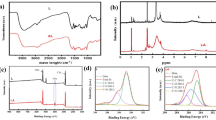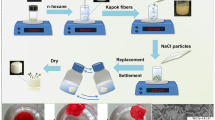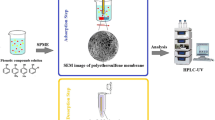Abstract
In this study, we successfully fabricated biocomposite monoliths using a facile, cost-effective, and friendly method via the thermally induced phase separation method using Polystyrene, Lignin, and OV-POSS. The properties of the prepared composites were estimated using Fourier transform infrared measurement (FTIR), scanning electron microscopy (SEM), and thermogravimetric analyzer (TGA). Furthermore, wettability properties were studied using water and oil. FTIR analysis indicates Polyester, Lignin, and OV-POSS were physically blended. The investigation by SEM showed the successful merging of components. Moreover, it revealed that OV-POSS nanoparticles acted as a support for reduced surface roughness. TGA measurements revealed that thermal stability was much better with increased OV-POSS loading. OV-POSS modified monolith exhibited hydrophobic with water contact angles of more than 130°. Results indicate that the produced monolith has a good sorption behavior to oils and organic liquids, whereas PL10L-0.3P showed higher sorption capacities followed by PL10L-0.1P, PL10L, and PL, respectively. The performance of the monoliths on oil/water separation was investigated through the selective removal of oil or organic solvent from water. Hence, the monoliths showed high separation efficiency above 90% and good reusability. The analysis showed that the adsorption for the oil and solvent process followed the pseudo-second-order model with a linear regression coefficient (R2) of > 0.999. The equilibrium data fit well with the Langmuir model. Besides, thermodynamic parameter analysis results showed that the adsorption was spontaneous and endothermic. An economic study examining the obtained resulted in a rate of investment (ROI) of 38.12%, a breakeven point (BEP) of 44.70%; this research is expected to be useful for the monolith industry that has attractive potential in practical industrial water treatment.
Graphical abstract






















Similar content being viewed by others
References
Li S et al (2012) Enhancing oil-sorption performance of polypropylene fiber by surface modification via UV-induced graft polymerization of butyl acrylate. Water Sci Technol 66(12):2647–2652. https://doi.org/10.2166/wst.2012.444
Yu L et al (2023) Synthesis and characterization of highly efficient oil–water separation, recyclable, magnetic particles CoFe2O4/SDB. Polym Bull 80(4):3571–3584. https://doi.org/10.1007/s00289-022-04279-y
Dacrory S (2022) Development of mesoporous foam based on dicarboxylic cellulose and graphene oxide for potential oil/water separation. Polym Bull 79(11):9563–9574. https://doi.org/10.1007/s00289-021-03963-9
Medeiros ADLM et al (2022) Oily wastewater treatment: methods, challenges, and trends. Processes 10(4):743. https://doi.org/10.3390/pr10040743
Abidli A, Huang Y, Park CB (2020) In situ oils/organic solvents cleanup and recovery using advanced oil-water separation system. Chemosphere 260:127586. https://doi.org/10.1016/j.chemosphere.2020.127586
Darmokoesoemo H, Magdhalena PT, Kusuma H (2016) Telescope snail (Telescopium sp.) and Mangrove crab (Scylla sp.) as adsorbent for the removal of Pb 2+ from aqueous solutions. Rasayan J Chem 9(4):680–685
Islam MA et al (2018) Metal ion and contaminant sorption onto aluminium oxide-based materials: a review and future research. J Environ Chem Eng 6(6):6853–6869. https://doi.org/10.1016/j.jece.2018.10.045
Neolaka YA et al (2023) Adsorption of methyl red from aqueous solution using Bali cow bones (Bos javanicus domesticus) hydrochar powder. Results Eng 17:100824. https://doi.org/10.1016/j.rineng.2022.100824
Abiodun O-AO et al (2023) Remediation of heavy metals using biomass-based adsorbents: adsorption kinetics and isotherm models. Clean Technol 5(3):934–960. https://doi.org/10.3390/cleantechnol5030047
Naat JN et al (2021) Adsorption of Cu (II) and Pb (II) using silica@ mercapto (hs@ m) hybrid adsorbent synthesized from silica of Takari sand: optimization of parameters and kinetics. Rasayan J Chem 14(1):550–560. https://doi.org/10.31788/RJC.2021.1415803
Osman AI et al (2023) Methods to prepare biosorbents and magnetic sorbents for water treatment: a review. Environ Chem Lett. https://doi.org/10.1007/s10311-023-01603-4
Doherty WO, Mousavioun P, Fellows CM (2011) Value-adding to cellulosic ethanol: lignin polymers. Ind Crops Prod 33(2):259–276. https://doi.org/10.1016/j.indcrop.2010.10.022
Luong ND et al (2012) An eco-friendly and efficient route of lignin extraction from black liquor and a lignin-based copolyester synthesis. Polym Bull 68:879–890. https://doi.org/10.1007/s00289-011-0658-x
Khera RA et al (2020) Kinetics and equilibrium studies of copper, zinc, and nickel ions adsorptive removal on to Archontophoenix alexandrae: conditions optimization by RSM. Desalin Water Treat 201:289–300. https://doi.org/10.5004/dwt.2020.25937
Divyashri G et al (2023) Valorization of coffee bean processing waste for the sustainable extraction of biologically active pectin. Heliyon. https://doi.org/10.1016/j.heliyon.2023.e20212
Zhang H et al (2021) Ultralight, hydrophobic, sustainable, cost-effective and floating kapok/microfibrillated cellulose aerogels as speedy and recyclable oil superabsorbents. J Hazard Mater 406:124758. https://doi.org/10.1016/j.jhazmat.2020.124758
Ganewatta MS, Lokupitiya HN, Tang C (2019) Lignin biopolymers in the age of controlled polymerization. Polymers 11(7):1176
Alassod A et al (2020) Polypropylene/lignin blend monoliths used as sorbent in oil spill cleanup. Heliyon. https://doi.org/10.1016/j.heliyon.2020.e04591
Laurichesse S, Avérous L (2014) Chemical modification of lignins: towards biobased polymers. Prog Polym Sci 39(7):1266–1290
del Río JC et al (2020) Lignin monomers from beyond the canonical monolignol biosynthetic pathway: another brick in the wall. ACS Sustain Chem Eng 8(13):4997–5012. https://doi.org/10.1021/acssuschemeng.0c01109
Yao H et al (2022) Review on applications of lignin in pavement engineering: a recent survey. Front Mater 8:803524. https://doi.org/10.3389/fmats.2021.803524
Yang J, Ching YC, Chuah CH (2019) Applications of lignocellulosic fibers and lignin in bioplastics: a review. Polymers 11(5):751
Alkhateeb WJ (2021) Response surface optimization of cotton tufts opening degree using Box–Behnken designs. Int J Cloth Sci Technol 33(2):254–269
Zhang Z et al (2019) Lignin-polystyrene composite foams through high internal phase emulsion polymerization. Polym Eng Sci 59(5):964–972. https://doi.org/10.1002/pen.25046
Li D et al (2021) A new approach to produce polystyrene monoliths by gelation and capillary shrinkage. SCI CHINA-MATER 64(9):2272–2279
Alassod A et al (2023) Polypropylene-chitosan sponges prepared via thermal induce phase separation used as sorbents for oil spills cleanup. Polym Bull 80(5):4949–4964
Wang G et al (2017) Template-free synthesis of polystyrene monoliths for the removal of oil-in-water emulsion. Sci Rep 7(1):6534
Ibadat NF et al (2021) Preparation of polystyrene microsphere-templated porous monolith for wastewater filtration. Materials 14(23):7165
Yang B et al (2019) Synergistic and compatibilizing effect of octavinyl polyhedral oligomeric silsesquioxane nanoparticles in polypropylene/intumescent flame retardant composite system. Compos A Appl Sci Manuf 123:46–58. https://doi.org/10.1016/j.compositesa.2019.04.032
Vasquez KA et al (2012) Wetting properties induced in nano-composite POSS-MA polymer films by atomic layer deposited oxides. J Vacuum Sci Technol A 30(1):01A105
Valentini L et al (2012) POSS vapor grafting on graphene oxide film. Chem Phys Lett 537:84–87
Chew S et al (2011) Elasticity, thermal stability and bioactivity of polyhedral oligomeric silsesquioxanes reinforced chitosan-based microfibres. J Mater Sci - Mater Med 22(6):1365–1374
Cao S et al (2016) Study on structure and wetting characteristic of cattail fibers as natural materials for oil sorption. Environ Technol 37(24):3193–3199. https://doi.org/10.1080/09593330.2016.1181111
Bakatula EN et al (2018) Determination of point of zero charge of natural organic materials. Environ Sci Pollut Res 25:7823–7833
Cardenas-Peña AM, Ibanez JG, Vasquez-Medrano R (2012) Determination of the point of zero charge for electrocoagulation precipitates from an iron anode. Int J Electrochem Sci 7(7):6142–6153
Neolaka YA, Supriyanto G, Kusuma HS (2018) Adsorption performance of Cr (VI)-imprinted poly (4-VP-co-MMA) supported on activated Indonesia (Ende-Flores) natural zeolite structure for Cr (VI) removal from aqueous solution. J Environ Chem Eng 6(2):3436–3443. https://doi.org/10.1016/j.jece.2018.04.053
Aigbe UO et al (2021) Fly ash-based adsorbent for adsorption of heavy metals and dyes from aqueous solution: a review. J Market Res 14:2751–2774
Gao Y et al (2023) Carboxy-functionalized polyimide aerogel monoliths: synthesis, characterization and carbon dioxide adsorption. Polym Bull 80(4):4429–4442
Neolaka YA et al (2020) A Cr (VI)-imprinted-poly (4-VP-co-EGDMA) sorbent prepared using precipitation polymerization and its application for selective adsorptive removal and solid phase extraction of Cr (VI) ions from electroplating industrial wastewater. React Funct Polym 147:104451. https://doi.org/10.1016/j.reactfunctpolym.2019.104451
Neolaka YA et al (2021) Evaluation of magnetic material IIP@ GO-Fe3O4 based on Kesambi wood (Schleichera oleosa) as a potential adsorbent for the removal of Cr (VI) from aqueous solutions. React Funct Polym 166:105000. https://doi.org/10.1016/j.reactfunctpolym.2021.105000
Herman V et al (2015) Core double–shell cobalt/graphene/polystyrene magnetic nanocomposites synthesized by in situ sonochemical polymerization. RSC Adv 5(63):51371–51381
Zhang Z, Terrasson V, Guénin E (2021) Lignin nanoparticles and their nanocomposites. Nanomaterials 11(5):1336
Liu M et al (2019) Facile fabrication of superhydrophobic surface from fluorinated poss acrylate copolymer via one-step breath figure method and its anti-corrosion property. Polymers 11(12):1953
Raghu A et al (2007) Synthesis, characterization, and acoustic properties of new soluble polyurethanes based on 2, 2′-[1, 4-phenylenebis (nitrilomethylylidene) diphenol and 2, 2′-[4, 4′-methylene-di-2-methylphenylene-1, 1′-bis (nitrilomethylylidene)] diphenol. J Appl Polym Sci 106(1):299–308. https://doi.org/10.1002/app.26547
De Chirico A et al (2003) Flame retardants for polypropylene based on lignin. Polym Degrad Stab 79(1):139–145
Berthier D et al (2018) POSS nanofiller-induced enhancement of the thermomechanical properties in a fluoroelastomer terpolymer. Materials 11(8):1358
Chen R et al (2014) Biobased ternary blends of lignin, poly (lactic acid), and poly (butylene adipate-co-terephthalate): The effect of lignin heterogeneity on blend morphology and compatibility. J Polym Environ 22:439–448
Alassod A et al (2020) Fabrication of polypropylene/lignin blend sponges via thermally induced phase separation for the removal of oil from contaminated water. SN Appl Sci 2:1–10. https://doi.org/10.1007/s42452-020-03372-z
Bolognesi A et al (2005) Self-organization of polystyrenes into ordered microstructured films and their replication by soft lithography. Langmuir 21(8):3480–3485
Alassod A et al (2022) Using polypropylene needle punch nonwoven sorbents as the interceptor for oil in static and dynamic water experiments. Environ Technol 43(25):3919–3934
Islam SR et al (2022) Using various concentrations of SiO2 aerogel for oil wicking, spreading, and interception tests of 3D weft-knitted spacer fabrics. J Text Inst 114:1–11
Alassod A, Abedalwafa MA, Xu G (2021) Evaluation of polypropylene melt blown nonwoven as the interceptor for oil. Environ Technol 42(18):2784–2796
Alassod A et al (2021) Polypropylene/lignin/POSS nanocomposites: thermal and wettability properties, application in water remediation. Materials 14(14):3950
Alassod A, Xu G (2021) Comparative study of polypropylene nonwoven on structure and wetting characteristics. J Text Inst 112(7):1100–1107
Islam SR et al (2022) 3D Weft-knitted spacer fabrics (WKSFs) coated with silica aerogels as oil intercepting sorbents for use in static and dynamic water tests. Ind Crops Prod 186:115169
Neolaka YA et al (2021) Indonesian Kesambi wood (Schleichera oleosa) activated with pyrolysis and H2SO4 combination methods to produce mesoporous activated carbon for Pb (II) adsorption from aqueous solution. Environ Technol Innov 24:101997. https://doi.org/10.1016/j.eti.2021.101997
Raghav S, Kumar D (2018) Adsorption equilibrium, kinetics, and thermodynamic studies of fluoride adsorbed by tetrametallic oxide adsorbent. J Chem Eng Data 63(5):1682–1697
Omar BM et al (2023) Wheat husk-based sorbent as an economical solution for removal of oil spills from sea water. Sci Rep 13(1):2575. https://doi.org/10.1038/s41598-023-29035-8
Mahmood T et al (2011) Comparison of different methods for the point of zero charge determination of NiO. Ind Eng Chem Res 50(17):10017–10023. https://doi.org/10.1021/ie200271d
Dong T, Wang F, Xu G (2015) Sorption kinetics and mechanism of various oils into kapok assembly. Mar Pollut Bull 91(1):230–237
Budiana IGMN et al (2021) Synthesis, characterization and application of cinnamoyl C-phenylcalix [4] resorcinarene (CCPCR) for removal of Cr (III) ion from the aquatic environment. J Mol Liq 324:114776
Alassod A et al (2022) Functionalization of aminoalkylsilane-grafted cotton for antibacterial, thermal, and wettability properties. RSC Adv 12(32):20906–20918. https://doi.org/10.1039/D2RA03214G
Jing P et al (2013) Ultra-low density porous polystyrene monolith: facile preparation and superior application. J Mater Chem A 1(35):10135–10141. https://doi.org/10.1039/C3TA11761H
Vo TH et al (2021) Amphibious superamphiphilic polystyrene monolith with underwater superoleophilicity: capture of underwater oil. Appl Surf Sci 570:151142. https://doi.org/10.1016/j.apsusc.2021.151142
Yang X et al (2015) Hierarchical porous polystyrene monoliths from polyHIPE. Macromol Rapid Commun 36(17):1553–1558. https://doi.org/10.1002/marc.201500235
Neolaka YA et al (2020) The adsorption of Cr (VI) from water samples using graphene oxide-magnetic (GO-Fe3O4) synthesized from natural cellulose-based graphite (kusambi wood or Schleichera oleosa): Study of kinetics, isotherms and thermodynamics. J Market Res 9(3):6544–6556. https://doi.org/10.1016/j.jmrt.2020.04.040
Neolaka YA et al (2022) Efficiency of activated natural zeolite-based magnetic composite (ANZ-Fe3O4) as a novel adsorbent for removal of Cr (VI) from wastewater. J Market Res 18:2896–2909. https://doi.org/10.1016/j.jmrt.2022.03.153
Senol-Arslan D (2022) Isotherms, kinetics and thermodynamics of pb (ii) adsorption by crosslinked chitosan/sepiolite composite. Polym Bull 79(6):3911–3928. https://doi.org/10.1007/s00289-021-03688-9
Wang J, Zheng Y, Wang A (2014) Kinetic and thermodynamic studies on the removal of oil from water using superhydrophobic kapok fiber. Water Environ Res 86(4):360–365. https://doi.org/10.2175/106143013x13807328849693
Mahreni M et al (2022) Synthesis of metal organic framework (MOF) based Ca-alginate for adsorption of malachite green dye. Polym Bull 79(12):11301–11315. https://doi.org/10.1007/s00289-022-04086-5
Ifa L et al (2022) Techno-economics of coconut coir bioadsorbent utilization on free fatty acid level reduction in crude palm oil. Heliyon. https://doi.org/10.1016/j.heliyon.2022.e09146
Kusuma HS, Izzah DN, Linggajati IWL (2023) Microwave-assisted drying of Ocimum sanctum leaves: analysis of moisture content, drying kinetic model, and techno-economics. Appl Food Res 3(2):100337. https://doi.org/10.1016/j.afres.2023.100337
Soetaredjo FE et al (2021) Ecological-safe and low-cost activated-bleaching earth: preparation, characteristics, bleaching performance, and scale-up production. J Clean Prod 279:123793. https://doi.org/10.1016/j.jclepro.2020.123793
Author information
Authors and Affiliations
Corresponding author
Ethics declarations
Conflict of interest
The authors declare that they have no conflict of interest.
Additional information
Publisher's Note
Springer Nature remains neutral with regard to jurisdictional claims in published maps and institutional affiliations.
Rights and permissions
Springer Nature or its licensor (e.g. a society or other partner) holds exclusive rights to this article under a publishing agreement with the author(s) or other rightsholder(s); author self-archiving of the accepted manuscript version of this article is solely governed by the terms of such publishing agreement and applicable law.
About this article
Cite this article
Alassod, A., Alkhateeb, W., Alghoraibi, I. et al. Facile fabrication of polystyrene/lignin /OV-POSS nanocomposite monolith by thermally induced phase separation method for wastewater cleanup. Polym. Bull. 81, 10081–10118 (2024). https://doi.org/10.1007/s00289-024-05193-1
Received:
Revised:
Accepted:
Published:
Issue Date:
DOI: https://doi.org/10.1007/s00289-024-05193-1




